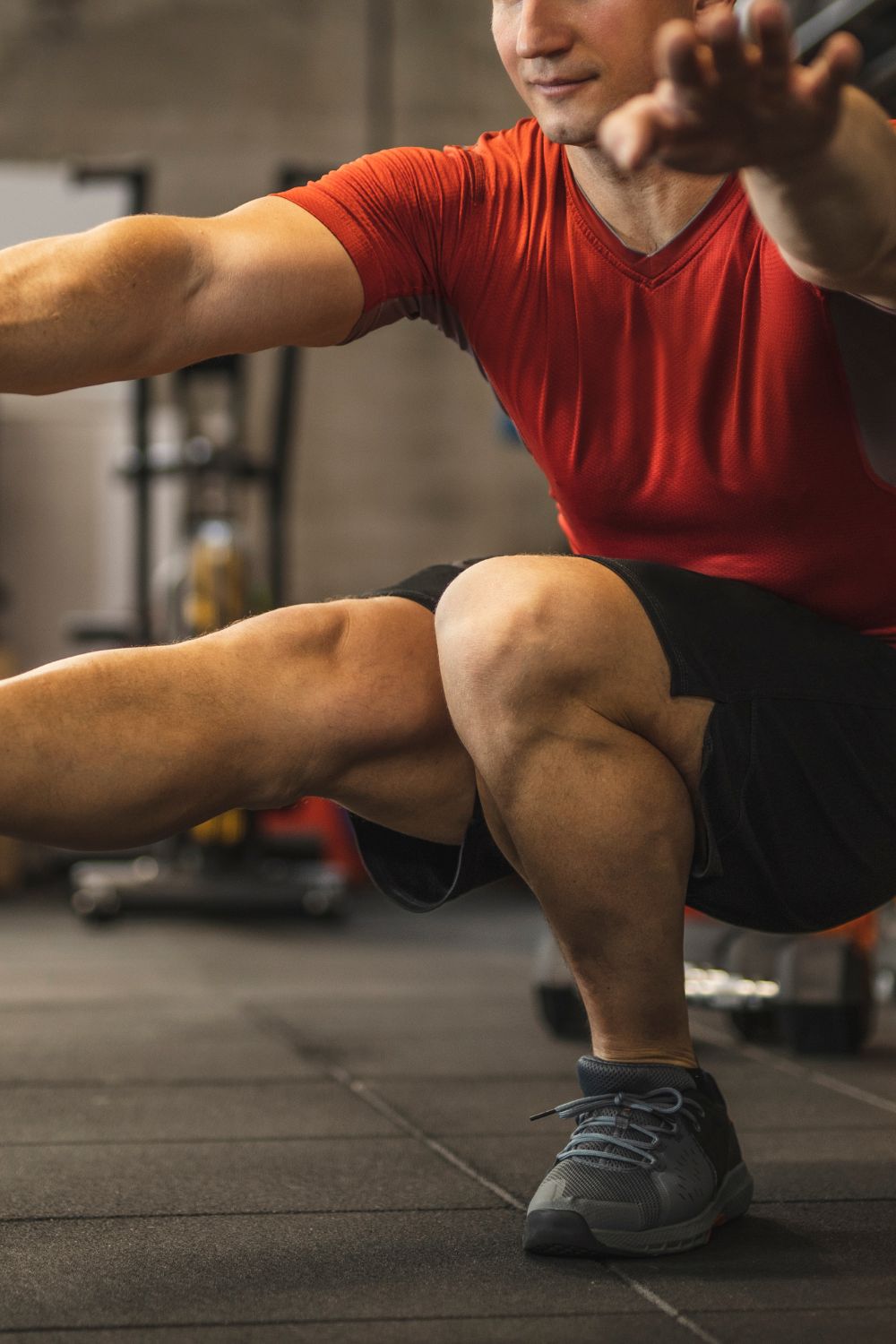If you’ve ever tried pistol squats, you know that they are a challenging and rewarding exercise. However, sometimes during this exercise, you might experience a slight discomfort in one knee. The big question is, should you power through it, thinking your legs are just too weak, or is it a sign to stop and reevaluate your approach? In this article, we’ll explore the common causes of knee discomfort during pistol squats, offer guidance on whether you should continue, and provide tips for strengthening your legs while ensuring safety.
Understanding Pistol Squats
Before we dive into addressing discomfort, let’s briefly explain what pistol squats are. Pistol squats are a type of single-leg squat that require balance, flexibility, and strength. This exercise targets your quadriceps, hamstrings, glutes, and core. To perform a pistol squat, stand on one leg and extend the other leg in front of you while lowering your body down as if you’re sitting in a chair. It’s an excellent way to build lower body strength and mobility.
The Common Causes of Knee Discomfort
Experiencing discomfort in one knee during pistol squats can be disheartening, but it’s essential to pinpoint the root cause. Some common reasons for knee discomfort during pistol squats include:
- Imbalance in Strength: Uneven leg strength can result in improper form, leading to discomfort or pain in the weaker knee.
- Poor Technique: Executing pistol squats with incorrect form can put unnecessary stress on the knee joint, causing discomfort.
- Mobility Issues: Limited ankle and hip mobility can affect the way you perform pistol squats, leading to knee discomfort.
- Muscle Tightness: Tight muscles, particularly in the quadriceps and hip flexors, can exacerbate knee discomfort during pistol squats.
Now that we’ve identified potential causes, let’s discuss whether you should power through the discomfort or consider making changes to your routine.
To Continue or Not to Continue?
The decision to continue with pistol squats despite experiencing discomfort in one knee isn’t one-size-fits-all. It depends on the severity of the discomfort and the underlying cause. Here are some guidelines to help you make an informed decision:
1. Evaluate the Pain Level
If the discomfort in your knee is mild and transient, it might be a sign of your body adapting to the exercise. In this case, it’s usually safe to continue, but with caution. However, if the pain is sharp, persistent, or gets worse, it’s crucial to stop and address the issue.
2. Check Your Form
Review your pistol squat technique. Are you maintaining proper alignment, with your knee tracking over your toes? If your form is incorrect, this could be a significant contributor to the discomfort. Consider seeking guidance from a fitness professional to correct your form.
3. Strengthen Imbalances
If your discomfort is due to muscle imbalances, it’s a clear sign that your legs might need more strength training. Focus on exercises that target the weaker leg, like lunges and step-ups. Incorporating exercises to strengthen your quadriceps and hamstrings can help balance your leg strength.
4. Work on Mobility
Limited ankle or hip mobility can lead to knee discomfort. Spend time improving your mobility with stretches and exercises. This can reduce strain on your knee during pistol squats.

5. Listen to Your Body
Ultimately, your body knows best. If the discomfort persists or worsens, don’t push through it. Over time, this could lead to more severe issues or injuries. Taking a step back and addressing the problem is a wise choice.
Tips for Strengthening and Safety
Whether you decide to continue with pistol squats or not, it’s essential to prioritize your leg strength and knee health. Here are some tips to help you on your fitness journey:
1. Strengthen Your Legs
Incorporate a variety of leg-strengthening exercises into your routine. Lunges, step-ups, squats, and leg presses can help build balanced leg strength.
2. Stretch and Mobilize
Regularly stretch your quadriceps, hip flexors, and hamstrings to improve your mobility. Consider adding yoga or mobility-focused workouts to your routine.
3. Gradual Progression
If you choose to continue with pistol squats, progress gradually. Start with assisted pistol squats, using a support or elevation to reduce the load on your knee. As your strength and technique improve, gradually transition to unassisted pistol squats.
4. Seek Professional Guidance
A certified personal trainer or physical therapist can provide valuable guidance. They can assess your form, create a tailored strength and mobility plan, and monitor your progress to ensure your knee discomfort diminishes.
5. Listen to Your Body
Always pay attention to your body’s signals. If the discomfort persists or worsens, consult a healthcare professional to rule out any underlying issues or injuries.
Conclusion
Experiencing discomfort in one knee during pistol squats is a common challenge for many fitness enthusiasts. The decision to continue or halt the exercise depends on various factors, including the severity of the discomfort, your technique, and your body’s individual needs. Regardless of your choice, prioritizing leg strength and knee health is paramount. By strengthening your legs, improving your mobility, and seeking professional guidance when needed, you can work towards pain-free pistol squats and a healthier, stronger lower body.
Remember, everyone’s fitness journey is unique, and there’s no shame in modifying your routine to ensure your safety and well-being. Whether you’re aiming to conquer pistol squats or exploring alternative exercises, the key is to stay committed to your fitness goals while listening to your body every step of the way.
A comparison tabular on this
Here’s a tabular comparison of the main points discussed in the article regarding “Dealing with Discomfort in One Knee During Pistol Squats: Tips for Strengthening and Safety.
| Aspect | Continue with Pistol Squats | Consider Alternatives |
|---|---|---|
| Evaluation of Pain Level | If discomfort is mild and transient, consider continuing with caution. | If the pain is sharp, persistent, or worsening, it’s essential to stop and address the issue. |
| Check Your Form | Review and correct your pistol squat technique. Seek guidance from a fitness professional if needed. | Consider alternatives if poor form contributes to discomfort. |
| Strengthen Imbalances | Focus on exercises that target the weaker leg and balance leg strength. | Explore alternative leg-strengthening exercises. |
| Work on Mobility | Improve ankle and hip mobility to reduce strain on the knee during pistol squats. | Incorporate mobility exercises and stretches into your routine. |
| Gradual Progression | Progress gradually by starting with assisted pistol squats and transitioning to unassisted as strength and technique improve. | Consider alternative exercises and gradually build leg strength. |
| Seek Professional Guidance | Consult a certified personal trainer or physical therapist for a tailored plan and progress monitoring. | If discomfort persists, consult a healthcare professional to rule out underlying issues or injuries. |
| Listen to Your Body | Pay attention to your body’s signals and prioritize safety. | Always listen to your body and prioritize safety and well-being. |
This table provides a quick comparison of the two options: continuing with pistol squats and considering alternatives, and the factors to consider when making that decision. It helps readers make an informed choice based on their specific circumstances.
Final words
In the world of fitness and strength training, encountering challenges and discomfort is all part of the journey. Whether you decide to power through discomfort during pistol squats or opt for alternatives, the key is to prioritize your health and safety above all else.
Remember, it’s perfectly okay to modify your fitness routine to suit your individual needs. The most important aspect of your journey is to stay committed to your goals while paying close attention to your body’s signals. Strengthening your legs and working on mobility are valuable investments in your overall fitness, and these efforts will pay off in the long run.
If you choose to continue with pistol squats, ensure you do so with proper form, gradual progression, and professional guidance when needed. And if you decide to explore alternative exercises, there are plenty of effective options to help you achieve your leg strength and mobility goals.
Your fitness journey is unique, and there’s no one-size-fits-all solution. Trust your body, be patient, and stay motivated. Whether you’re conquering pistol squats or discovering new exercises, your commitment to health and well-being is what truly matters.
So, go ahead, make an informed decision, adapt as needed, and keep striving for a stronger, healthier you. Your fitness journey is a personal adventure, and the path you choose is entirely yours to explore.

Hey there, it’s Mike Rrsq, the Editor-in-Chief over at Jsquat.com, and I’m absolutely obsessed with all things squat fitness! I’ve been lucky enough to get some serious recognition for my work in this field. With a solid background in the fitness and wellness industry, I’ve been there right from the get-go, helping shape this website into what it is today.
You see, I’m not just the boss around here; I’m also a passionate contributor. I love sharing my insights through my articles, and trust me, they’re not your run-of-the-mill stuff. Each piece I write is a labor of love, filled with my expertise and real-world experience in the fitness universe. So, if you’re into fitness and looking for some inspiration, you’re in the right place!

